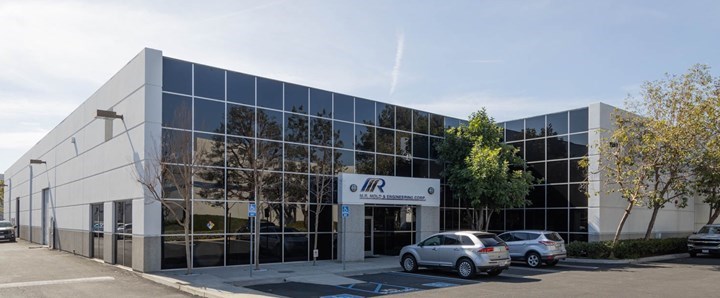
Finding a Niche in LSR Tooling
Mixed in amidst the soft, translucent liquid silicone rubber (LSR) parts, the shiny, metallic chunk of silica mineral in M.R. Mold & Engineering’s display shelf provides a striking contrast. The fact that such smooth, squishy and clear materials are derived in part from a hard, opaque rock is counterintuitive, but for M.R. Mold’s founder and president, Rick Finnie, displaying the parts alongside their unlikely source helps customers understand the strengths and challenges of LSR.
The toughness of silica means high wear and tear on the material-facing elements of the machines that process LSR is quite high, but it also lends the material its unique abilities to resist heat and chemicals.
Founded in 1985 with Finnie as the lone employee, M.R. Mold now has a staff of more than 30, including many highly skilled moldmakers. While it started in plastics molds, and still makes them today, it was a pivot to LSR tooling in the early 2000s that has made the Southern California shop one of the leading manufacturers of LSR tooling, as well as complementary equipment like cold runners and stuffer boxes, in the U.S.
Finnie’s start in manufacturing came as a teenager alongside his father, who worked as a tool and cutter grinder. “Back in the day, if you wanted a shape in a piece of steel, you had to have a cutter with that shape on it,” Finnie says. Eventually, Finnie was hired on by one of his father’s customers—LSR and rubber moldmaker Kipe Molds—and his introduction the unique material and its myriad challenges was made.
In 1985 when Finnie struck out on his own, he did so with the intention of winning general machining work, but in the attorney’s office working up the incorporation documents, he learned his preferred company name—M.R. Machine—was taken, and on the spot, M.R. Mold and Engineering was born, with the “mold” in the new name being prophetic.
“The original company was called M.R. Machine because I was planning on engaging anything that had to do with machining,” Finnie says, “but primarily I was getting customers that were all in the mold building business.”
Finding a Niche
In the late 90s as once abundant computer and consumer electronic moldmaking business began moving to Asia, many moldmakers struggled to find their businesses a safe harbor. In the early aughts, Finnie remembers a presentation at the American Mold Builders Assn. (AMBA) given by long-time plastics trade journalist Clare Goldsberry that both inspired him and gave him pause.
“So much business was being lost to China that a lot of the old school tool makers were calling on the AMBA to march on Washington and make the politicians make it illegal to buy molds from China,” Finnie remembers, “and Clare gave a marketing presentation and she told everyone to quit their whining and develop a niche and market your niche.”
At dinner that evening with fellow moldmakers, Finnie recalls everyone at the table loudly proclaiming their niche, while he was mostly silent. “I’m sitting there thinking, ‘Man I’m screwed, I don’t have a niche,’” Finnie says. “Then I thought, ‘Well, we do have this silicone business that we’ve been doing that we’re kind of ignoring, maybe we should be more serious about it?’”
Finnie purchased an Engel LSR machine in 2003 to begin sampling silicone tools. In time, the company developed its own cold runner system, stuffer box and standardized mold bases for silicone since traditional mold bases didn’t always work with LSR.
In March 2020, the company completed a move into a larger 23,000-ft2 space, which houses six injection molding machines—four Engel and two Arburg—ranging in clamp force from 55 to 120 tons, that can run both LSR and standard thermoplastics. On the machining side, the facility has five CNCs; two lathes; a sinker, CNC wire, and two manual EDMs; a hard-milling high-speed CNC mill; and a 5-axis CNC mill. The company also added an 18-ft tall vertical storage unit to support lean manufacturing. More recently it installed an SLS 3D printer from 3D Systems and added Moldex3D simulation capabilities.
Although the pivot to LSR has helped M.R. Mold find its niche, it finds it still has to remind its customers of its plastics moldmaking capabilities. Recently, difficulties with an LSR overmolding project prompted Finnie to contact the customer. “I said guys, why don’t you just have us make the PC tools, and they’re like, ‘Well you’re the silicone guys,’ and I said no, ‘We make plastic tools too; we just haven’t been advertising it.’”
Read: Finding a Niche in LSR Tooling
With the skills to serve both markets, M.R. Mold had to rethink its trade show display and what it presented to potential customers. “The last few years, I had Geri [Anderson; M.R.’s marketing director] make sure to bring some plastic parts to these trade shows,” Finnie says. “We’ve kind of overdone it where people don’t even realize that we are capable of making plastic tools, and the guys actually kind of enjoy it.” Given the comparative simplicity of a mold for thermoplastics compared to LSR, which flows like water obviating venting—factors that dramatically change their design. “You can always tell when a plastics guy designs an LSR tool,” Finnie says.
Finnie will be sharing LSR mold design tips and more at the upcoming LSR 2022 Conference in Irvine, Calif. (Sept. 13-15).

M.R. Mold moved into its new facility in March 2020.
Photo Credit: M.R. Mold & Engineering

Leave a Reply